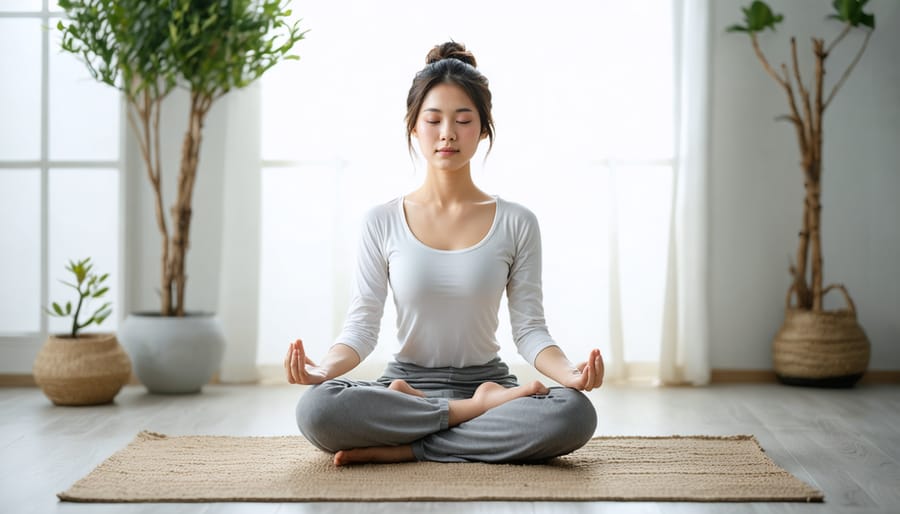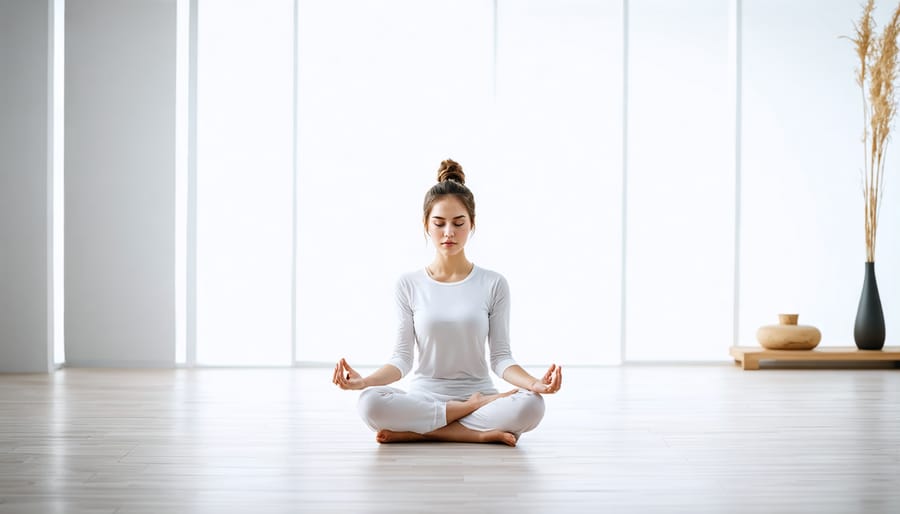
Transform your hectic day with just 8 minutes of mindfulness meditation – a scientifically-proven practice that can lower stress, enhance focus, and boost emotional well-being. In our constantly connected world, finding extended periods for meditation often feels impossible, but research shows that even short, consistent practice delivers remarkable benefits. This quick yet powerful meditation format fits perfectly into your morning routine, lunch break, or evening wind-down, making it ideal for busy professionals, parents, and anyone seeking a practical way to cultivate mindfulness.
Think of it as your daily mental reset button – as essential as your morning coffee, but with lasting benefits that extend far beyond those 8 minutes. Whether you’re new to meditation or looking to establish a more consistent practice, this time-efficient approach offers the perfect balance between effectiveness and accessibility. Let’s explore how these precious 8 minutes can become your daily sanctuary of calm and clarity.
Why 8 Minutes Can Transform Your Emotional Well-being
The Science Behind Quick Mindfulness
Recent studies have shown that even brief moments of mindfulness can create meaningful changes in our brains and bodies. As someone who initially doubted whether eight minutes could make a difference, I was amazed to discover the science backing these short practices. Research from Harvard Medical School reveals that just 8-10 minutes of daily meditation can reduce anxiety levels by up to 22% and improve focus within two weeks.
The magic lies in what scientists call the relaxation response, a state that counteracts our stress-driven “fight or flight” mode. Through mindfulness-based stress reduction, even these brief sessions trigger the release of feel-good hormones like serotonin while lowering cortisol levels.
What’s particularly exciting is that neuroimaging studies show positive brain changes can begin in as little as eight days of consistent practice. The amygdala, our brain’s emotional center, actually becomes less reactive to stress, while areas associated with attention and emotional regulation become stronger.
Perfect for Busy Lives
Let’s be honest – finding an hour to meditate each day sounds wonderful, but for most of us, it’s simply not realistic. This is exactly why 8 minutes is the sweet spot for meditation. It’s long enough to create meaningful change in your brain and body, yet short enough to fit into even the busiest schedule.
Think about it: 8 minutes is shorter than your morning coffee run or your social media scroll before bed. It’s about the length of two favorite songs or the time it takes to sort through your email inbox. When you put it that way, it suddenly feels much more doable, doesn’t it?
Research shows that even brief meditation sessions can reduce stress and improve focus. By choosing an 8-minute practice, you’re more likely to stick with it because it feels achievable. It’s like taking baby steps toward better mental health – small, consistent actions that add up to significant results over time.
Remember, a sustainable practice is one you’ll actually do, and 8 minutes hits that perfect balance between effectiveness and accessibility.
Your 8-Minute Mindfulness Journey

Setting Up Your Space
Creating your perfect meditation spot doesn’t need to be complicated – in fact, simplicity is key! I’ve found that dedicating even a small corner of your home can make a world of difference in your practice. Choose a quiet space where you won’t be disturbed for those precious 8 minutes. This could be a cozy nook in your bedroom, a peaceful spot in your living room, or even a quiet corner of your home office.
Make this space inviting by adding a comfortable cushion or chair – whatever feels right for you. I personally love using a soft meditation cushion, but a regular chair works just as well. The key is to maintain good posture without feeling strained.
Consider the lighting in your space. Natural light is wonderful, but soft artificial lighting can work beautifully too. Some of my readers love adding personal touches like a small plant, a meaningful photo, or a gentle-scented candle. Just remember, less is more – you want to create a calming environment, not a cluttered one.
Temperature matters too! Ensure your space isn’t too hot or cold, as physical comfort helps maintain focus during your practice.
The Breathing Technique
Let’s explore the heart of this meditation practice: mindful breathing. The technique we’ll use is one of my favorite soothing breath techniques, perfect for both beginners and experienced practitioners.
Start by finding a comfortable seated position, whether that’s cross-legged on a cushion or in your favorite chair. Rest your hands gently on your thighs, palms facing up or down – whatever feels most natural to you. Softly close your eyes or maintain a gentle gaze a few feet in front of you.
Now, breathe naturally through your nose. There’s no need to force or change your breath; simply observe it as it flows in and out. Notice the sensation of cool air entering your nostrils and warmer air leaving. Feel your belly expand on the inhale and fall on the exhale.
As you continue breathing, try counting your breaths: “one” on the inhale, “two” on the exhale, up to ten. Then start over. If your mind wanders (and trust me, it will!), simply notice that thought and gently guide your attention back to your breath. Think of it like training a puppy – with patience and kindness.
Remember, there’s no “perfect” way to breathe here. Your natural rhythm is exactly what you need in this moment.

Body and Mind Connection
During these precious eight minutes, you’ll discover the profound body-mind connection that makes mindfulness meditation so powerful. Think of it as having a conversation with yourself, where both your body and mind are equal participants in the dialogue.
As you settle into your practice, notice how your breathing affects different parts of your body. Perhaps you’ll feel your shoulders soften with each exhale, or your jaw gradually release tension you didn’t even realize was there. This awareness isn’t just about physical sensations – it’s about understanding how your thoughts and emotions manifest in your body.
I remember when I first started practicing, I was surprised to discover how much anxiety I was holding in my chest. Simply acknowledging this tension often helped it dissolve naturally. This is the beauty of mindful awareness – it doesn’t force change but allows it to happen organically.
During your eight-minute practice, you might notice your mind wandering (mine certainly does!), and that’s perfectly normal. The key is to acknowledge these thoughts without judgment and gently guide your attention back to your breath or body sensations. This simple act of noticing and returning is like building a muscle – it strengthens the connection between your mental and physical experience.
Remember, this isn’t about achieving a completely blank mind or perfect posture. It’s about creating a loving, accepting space where you can observe yourself just as you are, moment by moment. This gentle awareness is what makes these eight minutes truly transformative.
Making It Part of Your Daily Routine
Morning vs Evening Practice
When it comes to your 8-minute mindfulness practice, timing can make a surprising difference. As someone who’s experimented with both morning and evening meditation, I can tell you that each offers its own unique benefits.
Morning practice sets a peaceful tone for your entire day. When you meditate shortly after waking up, you’re essentially creating a clean slate for your mind before the day’s challenges begin. Many of my readers report feeling more focused and resilient when they start their day this way. Plus, morning meditation can help you establish a consistent routine since there are fewer distractions to derail your practice.
Evening meditation, on the other hand, serves as a wonderful way to decompress and process the day’s events. It can help you transition from work mode to relaxation mode, making it easier to enjoy quality time with family or prepare for restful sleep. I’ve found that evening practice tends to be deeper because you’re already carrying experiences that you can acknowledge and release.
The best time? It’s truly personal. I always tell my community members to try both and see what resonates. Some even practice twice daily – a gentle morning session to center themselves and a deeper evening session to unwind. The key is choosing a time when you can consistently show up for yourself without feeling rushed.
Remember, consistency matters more than timing. Pick the schedule that naturally fits into your daily routine, and you’ll be more likely to stick with it long-term.

Building Long-term Resilience
Think of mindfulness meditation like tending to a garden – it’s not about instant results but rather the consistent care that leads to lasting growth. I’ve witnessed this transformation in many of our community members who started with just 8 minutes a day and gradually built an unshakeable foundation of emotional resilience.
When you practice mindfulness meditation regularly, you’re essentially training your brain to respond rather than react. It’s like building a muscle – each session strengthens your ability to stay centered during life’s inevitable storms. One of my clients, Sarah, shared how after three months of consistent practice, she noticed she was handling workplace stress with remarkable composure, something that would have previously sent her into a spiral of anxiety.
The beauty of an 8-minute practice lies in its accessibility. It’s short enough to maintain consistently yet long enough to create meaningful change. Research shows that regular meditation practice can actually alter the brain’s structure, particularly in areas associated with emotional regulation and stress response.
To build this resilience, commit to your daily practice without judgment. Some days will feel easier than others, and that’s perfectly normal. What matters most is showing up for yourself, even when – especially when – life gets chaotic. Remember, you’re not just practicing meditation; you’re cultivating a lifelong skill of emotional strength and balance.
As someone who once struggled to find time for meditation, discovering this 8-minute practice truly changed my daily routine. It showed me that mindfulness doesn’t require hours of sitting in silence – just a genuine commitment to show up for yourself. Whether you’re dealing with work stress, family obligations, or simply seeking a moment of peace, these eight minutes can become your daily sanctuary.
Remember, every master meditator started as a beginner. Your practice doesn’t need to be perfect; it just needs to be consistent. Start with these eight minutes tomorrow morning, and notice how it affects your day. You might be surprised by how this small investment of time can transform your relationship with yourself and the world around you.
I invite you to join our growing community of mindful individuals. Share your experiences, celebrate your progress, and remember – every moment of mindfulness is a gift to yourself.



